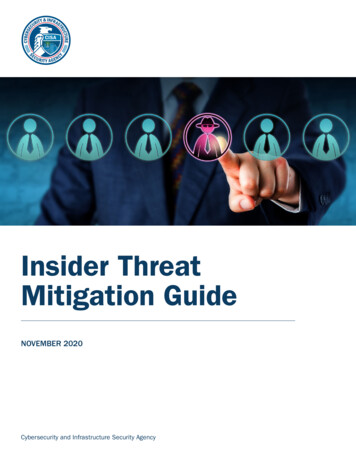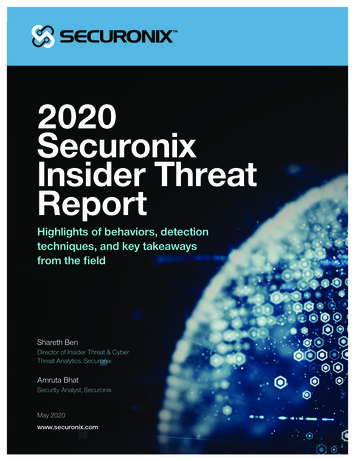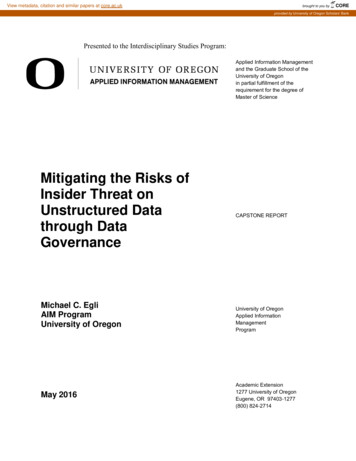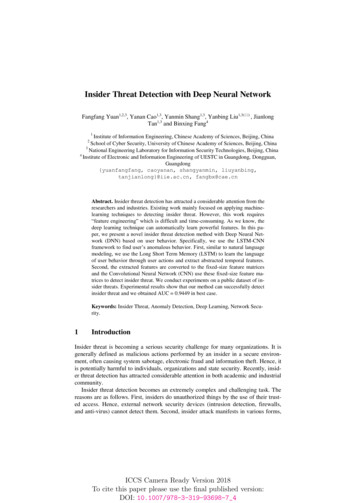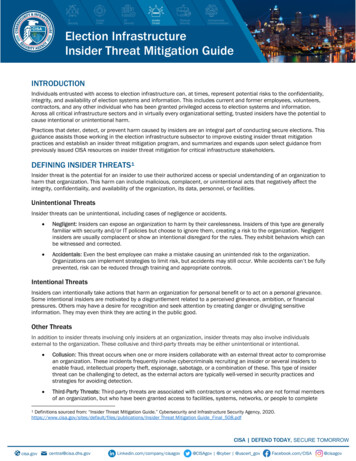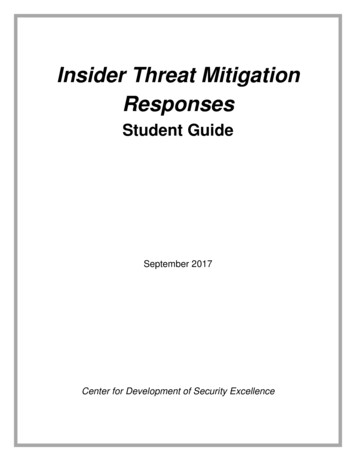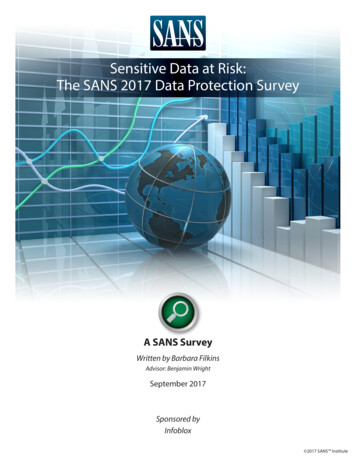
Transcription
Behavioral Science in Insider Threat StudentGuideProduct #: INT 290Behavioral Science and Insider ThreatCourse IntroductionCourse IntroductionNewscaster: In regional headlines this morning a bomb exploded in a major internationalshopping district yesterday. Government officials have confirmed that six Americans wereamong those killed in the attack. The bombing has been linked to the unauthorized disclosure ofinformation involving U.S. activities in the region.Female 1: Rich Rich: Oh, what’s going on with Karl?Female 1: I just heard someone say that someone gave up our classified program but Karl?Rich: You don’t think it’s connected to the bombing, do you?Female 1: Oh my God, I know he’s been stressed lately but if only I could’ve done something.Could I have prevented this?Screen text: VIDEOSylvia: The preceding video clip was from the National Insider Threat Task Force’s Any GivenDay video, which can be viewed in its entirety in the Course Resources.Malicious insiders have caused, and can do, tremendous damage to national security. In manycases, damage could have been avoided if one observant colleague spoke up.By saving a coworker from making a bad decision, you might be protecting our national security.This course will cover behavioral science and its application to insider threat programs.Center for Development of Excellence (CDSE)Page 1
Behavioral Science in Insider Threat StudentGuideProduct #: INT 290IntroductionNarration: Welcome to the Behavioral Science in Insider Threat course! Take a moment toreview the course objectives.Screen text: Behavioral Science and Insider Threat CourseCourse Objectives: Determine why an organization may require the use of behavioral science to help addresspotential insider threats Explain how behavioral science may be applied to help prevent insider threats in anorganization Explain how behavioral science is used to determine possible insider threatsOrganizational CultureInsider ThreatNarration: In this lesson, we’ll define behavioral science and organizational culture, and relatethe importance of organizational culture to behavioral science. Insider Threat is defined in bothDoD and National Policy. We’ll use the definition from Department of Defense Directive5205.16.Insider threat is the threat insiders pose to DoD and U.S. Government installations, facilities,personnel, mission or resources. This threat can include damage to the United States throughespionage, terrorism, unauthorized disclosure of national security information, or through theloss or degradation of departmental resources or capabilities.Screen text:Learning Objectives: Define behavioral science Define organizational culture Relate the importance of organizational culture to behavioral scienceDoD Directive 5205.16Incorporating Change 23. POLICY. It is DoD policy that:a. DoD will implement the National Insider Threat Policy and Minimum Standards forExecutive Branch Insider Threat Programs in accordance with References (b), (e), (f),and (h).b. The threat that an insider may do harm to the security of the United States requires theintegration and synchronization of programs across the Department. This threat caninclude damage to the United States through espionage, terrorism, unauthorizedCenter for Development of Excellence (CDSE)Page 2
Behavioral Science in Insider Threat StudentGuideProduct #: INT 290disclosure of national security information, or through the loss or degradation ofresources or capabilities.Policy and StandardsNarration: Insider Threat Programs are required for federal agencies, DoD components, andcleared industry. These programs are established in accordance with DoD and National Policy.You can access these policies in the Course Resources.While policies vary slightly based on the nature of your organization, all insider threat programpolicies require a multi-disciplinary approach to detect, deter, and mitigate insider threat.This must include law enforcement, counterintelligence, security, human resources, cybersecurity, and mental health or behavioral science professionals.Screen text: National Insider Threat Task Force2009 Fort Hood Shooting20102011 Executive Order 13587Wiki Leaks2012 Presidential Memorandum established the National Insider Threat Policy and MinimumStandards for Executive Branch Insider Threat Programs2013 Washington Navy Yard shooting2014 DoD Directive 5205.162015 DoD Directive 5205.832016 NISPOM Change 2ISL 2016-02To learn more about the Executive Order, NITTF Minimum Standards, DoD Insider ThreatProgram, or the DITMAC, visit the Course Resources.Knowledge CheckScreen text:Question 1 of 2Insider Threat Programs are required to have multi-disciplinary capabilities to include whichelements? Select all that apply; then select Submit. CybersecurityCounterintelligenceBehavioral Science or Mental HealthHuman ResourcesCenter for Development of Excellence (CDSE)Page 3
Behavioral Science in Insider Threat StudentGuideProduct #: INT 290Question 2 of 2Insider threat is limited to damage to the United States through espionage or terrorism alone.Select the best response; then select Submit. TrueFalseBehavioral ScienceNarration: As defined in the Merriam-Webster Dictionary, behavioral science is a branch ofscience (such as psychology, sociology, or anthropology) that primarily deals with human actionand often seeks to generalize about human behavior in society.At its core, it’s about human behavior, which cannot be predicted with 100% accuracy. However,by studying human behavior, we can apply a degree of risk management to the process.Not all organizations have behavioral science personnel; however, they do have the ability toreach out to external resources when needed. Behavioral scientists provide training, consultation,and research, and at times are involved with these aspects simultaneously.The U.S. Intelligence Community and federal law enforcement are supported by behavioralscientists in numerous ways. Some of these include clinical psychological assessment, personnelsecurity-related consultation, forensic psychology research, and Employee Assistance Program,or EAP, counseling.In addition to individual behavior, behavioral scientists consider organizational culture and itslink to insider threat.Screen text:Behavioral science is a branch of science that primarily deals with human action and often seeksto generalize about human behavior in society.What is behavioral science?By studying human behavior, we can apply a degree of risk management to the process.ConsultationTrainingResearch Clinical psychological assessment for incoming and on-board personnel (e.g.,psychological fitness for dutyOrganizational psychology focused on such issues as job analysis, selection,performance, leadership development, and climatePersonnel security-related consultation for insider threat program components (e.g.,Center for Development of Excellence (CDSE)Page 4
Behavioral Science in Insider Threat StudentGuide Product #: INT 290background investigations, counterintelligence)For academic and applied research, for example, to identify and validate “indicators” ofinsider riskForensic psychology research, analysis and consultation in support of criminalinvestigationsSpecialized operational psychology support (i.e., hostage rescue, counterintelligence,personnel recovery)Employee Assistance Program (EAP) counseling and referral services for the generalworkforceOrganizational CultureNarration: Organizational culture is the set of underlying beliefs, assumptions, values, and normsof interaction which contribute to the unique social and psychological environment of anorganization.Organizational culture is important because it functions as a “lens” which can influence attitudes,perceptions, behaviors, and expectations in the employee population.Look at some examples of how organizational culture relates to insider threat prevention,detection and mitigation efforts.Screen text:Organizational CultureWhy Is It Important? Loyalty, commitment to the mission and the organization Conformity with security-related rules and guidelines “Organizational citizenship behavior” – voluntary actions geared toward the greatergood, independent of personal gain Willingness to seek professional help for personal/psychological issues which coulddecrease reliability or effectiveness Vigilance about protecting the organization and national security interests, and reportingconcerning or suspicious behaviors if necessaryKnowledge CheckScreen text:Question 1 of 2Which of the following terms is identified as a branch of science that primarily deals with humanaction and often seeks to generalize about human behavior in society? Select the best response;then select Submit.Center for Development of Excellence (CDSE)Page 5
Behavioral Science in Insider Threat StudentGuide Product #: INT 290Behavioral scienceInsider threatSociologyOrganizational cultureQuestion 2 of 2An organization’s culture functions as a “lens” which can influence attitudes, perceptions, andbehaviors in the employee population. Select the best response; then select Submit. TrueFalseLesson ConclusionNarration: Great job with this lesson and achieving these objectives!Screen text:Learning Objectives: Define behavioral science Define organizational culture Relate the importance of organizational culture to behavioral scienceBehavioral ScientistsLesson ObjectivesNarration: In this lesson, we’ll investigate the role of behavioral science in an insider threat teamand how it’s applied within insider threat programs. Let’s get started.Screen text:Learning Objectives: Identify the role and value of behavioral science in a multi-disciplinary insider threatteam Explain how behavioral science is applied within insider threat programsInsider Threat ProgramNarration: How can Behavioral Scientists contribute to Insider Threat Programs?Psychologists and other behavioral scientists add value by helping identify, explain, andCenter for Development of Excellence (CDSE)Page 6
Behavioral Science in Insider Threat StudentGuideProduct #: INT 290contextualize concerning behaviors that come to the attention of an Insider Threat Hub. They canprovide expert consultation, training, and customized analytical tools to help distinguish betweenmere troubled employees and those presenting a genuine threat.Finally, behavioral scientists can operationalize current research to enhance an organization’sinsider threat deterrence, detection, and mitigation efforts. Behavioral science utilizes manydifferent methods and types of information, including empirical, observational and clinical data.In its Insider Threat Program Maturity Framework, NITTF addresses the importance ofbehavioral science in two of its 15 maturity framework elements, or MEs. In ME5, the NITTFMaturity Framework states that continuing education and training for Insider Threat Programpersonnel is vital to maintain currency and methodologies in the program disciplines. Among themost important are behavioral sciences and analytic methodologies, data analytics, security,privacy and civil liberties, and counterintelligence.ME15 adds that the human-centric nature of the insider threat issue increases the importance ofincorporating behavioral science perspective and expertise into an Insider Threat Program.A program with access to behavioral sciences expertise, either through internal departments andagencies or affiliated resources, can strengthen its capabilities to identify and assess types ofconcerning behavior, discern subconscious biases, and propose alternative hypotheses.Personnel with this expertise may provide additional context and insight into social/culturalmores that may impact mitigation strategies and furnish advice during periodic revisions toinsider threat indicators, triggers, and thresholds.Screen text: How Can Behavioral Scientists Contribute to Insider Threat Programs?IdentifyExplainContextualizeResearch Empirical Observational Clinical dataME5Includes stakeholders from a broad range of functional areas and others with specializeddisciplinary expertise to strengthen Insider Threat Program processes. Continuing education and training for Insider Threat Program personnel is vital tomaintain currency and methodologies in the program disciplinesBehavioral sciences and analytic methodologies, data analytics, security, privacy andcivil liberties, and counterintelligenceCenter for Development of Excellence (CDSE)Page 7
Behavioral Science in Insider Threat StudentGuideProduct #: INT 290ME5Employs behavioral science methodologies to help identify indicators of potential insider threats. Includes stakeholders from a broad range of functional areas and others with specializeddisciplinary expertise to strengthen Insider Threat Program processes.Strengthen its capabilities to: Identify and assess types of concerning behavior Discern subconscious biases Propose alternative hypothesisTo learn more about the NITTF Maturity Framework, visit the Course Resources.Insider Threat Program (cont.)Narration: Research is a critical aspect of behavioral science. Researchers conduct interviews,review case studies, and analyze data. One such organization that conducts research anddevelopment is the Defense Personnel and Security Research Center, or PERSEREC.PERSEREC, in its recently released technical report or TR 18-16, titled, “A Strategic Plan toLeverage the Social and Behavioral Sciences to Counter the Insider Threat” cites this: "InsiderThreat Programs recognize 'the humanity of human behavior' — the messiness, theinconsistency, and the adaptability — and in collaboration with other stakeholders, developstructured and supported interventions for those that may pose a potential threat. Social andbehavioral scientists are well-positioned to contribute to this mission by delivering robustempirical research and actionable, relevant recommendations to guide policy and practice."Screen text:PERSERECConclusionIn the words of one government SME, successful ITPs recognize “the humanity of humanbehavior” – the messiness, the inconsistency, and the adaptability – and in collaboration withother stakeholders, develop structured and supported interventions for those who may pose apotential threat. Social and behavioral scientists are well-positioned to contribute to this missionspace by delivering robust empirical research and actionable, relevant recommendations to guideboth policy and practice.Dr. GallagherNarration: Let's listen to a conversation with Dr. Robert Gallagher of the DoD Insider ThreatManagement and Analysis Center about behavioral science and the role behavioral scientistsplay in an insider threat program.Center for Development of Excellence (CDSE)Page 8
Behavioral Science in Insider Threat StudentGuideProduct #: INT 290VIDEO[Rebecca Morgan:] So many people have had the requirement to stand up an insider threatprogram and that has applied to DoD components, to federal agencies as well as to our industrypartners under the NISPOM. And, all of them had a requirement to include a mental healthprofessional or SME as part of the hub or the program management team.But I’m not sure everybody knows exactly what that means or what they would do. So you areproviding a role as a behavioral scientist at the DITMAC, do I have that right? [Dr. Gallagher:]Correct.[Rebecca Morgan:] Awesome, okay and so can you expand a little bit for us what the role ofbehavioral science is in an insider threat program?[Dr. Gallagher:] Sure so, the logic behind involving behavioral science is that insider threat isessentially a human behavior issue; people make a choice to act in a certain way. And so, themore we understand about why people do what they do, the better we can mitigate and controlthat kind of behavior. So, when you involve a behavioral scientist there are a number of waysthat behavioral scientists can contribute.The first one is in a consultative role. So consulting to analysts, leadership or anyone else in theinsider threat domain and helping them understand the context and the culture in which thebehavior is occurring, the things that might drive that behavior. And, then the more we knowabout that, the more we can do about it.[Rebecca Morgan:] And just to add, so when you say consultative role you are not talking aboutconsulting with the client as if you were a therapist, you’re talking about working with the othermembers of the insider threat program.[Dr. Gallagher:] Yes, of being part of that decision-making body of the team that’s looking at thebehavior, trying to understand the context and the terms of the behavior. And that would be therole of the behavioral scientists in that part of the picture. There’s also roles for behavioralscientists in research, trying to understand the larger context of why people do what they do andespecially as it relates to insider threat and there is a lot of vibrant research going on today.Psychologists or other types of behavioral scientists are frequently involved at EAPs or othertypes of care facilities and so they will be involved in evaluating the individuals when theypresent with a potential mental health challenge or a question about their stability. They'll beinvolved in evaluating and treating that individual. And then the last place where psychologistsor other types of behavioral scientists can get involved is typically in training.So, within the DITMAC I do a regular training series and we’ve done things, topics ranging fromthe process of radicalization to the indicators of violence and suicide. So, things along those linesare the primary ways that a behavioral scientist would function.Narration: In this webinar, Dr. Gallagher explained the roles of behavioral science in an InsiderCenter for Development of Excellence (CDSE)Page 9
Behavioral Science in Insider Threat StudentGuideProduct #: INT 290Threat Program. Behavioral scientists can provide consultation to the program, makerecommendations for individual treatment plans, support training and awareness, and conductresearch.Let's explore some of the primary approaches behavioral scientists use in research.Screen text: Provide consultation to the programMake recommendations for treatment plansSupport training and awarenessConduct researchListsNarration: Everyone makes lists and finds them useful, right?Individuals may think that a list of indicators is enough for discerning between an insider threatand a non-malicious actor. A cursory search turned up more than 20 distinct lists of behavioralindicators which vary in size from a handful to hundreds of items.There are three primary approaches to list development: reverse engineering cases, the rationalapproach, and science.Reverse engineering cases involves identifying and studying precursors to action in knowninsider threat cases. However, this approach can lead to backward orientation.The rational approach is where a subject matter expert, or SME, will rely on logic andexperience.Science is those items that discriminate between good and bad actors. The study of humanbehavior is complex, and humans are, in a sense, "messy".An indicator in one setting may not be an indicator in another. An indicator for one person maynot be an indicator for another. An indicator for me one day may not be an indicator on anotherday.Science can lead to false positives. The base rate of insider threat is very small. For almost anyindicator there will be more non-malicious actors than malicious ones.Just think, if we had a single, comprehensive list of ALL behavioral indicators of insider threat,we could screen for or monitor those indicators and eliminate all insider threats. But it isn’t thatCenter for Development of Excellence (CDSE)Page 10
Behavioral Science in Insider Threat StudentGuideProduct #: INT 290simple. Lists tend to treat all indicators as equally indicative and minimize critical thinking.Individuals tend to focus on and minimize selected items.Screen text:An indicator is an observable or reportable behavior or activity. Potential risk indicators ofinsider threat fall under numerous categories. For more information, view the job aids in CourseResources.1. Reverse Engineering Cases – Involves identifying and studying precursors to action inknown insider threat cases.2. The Rational Approach – A subject matter expert, or SME, will rely on logic andexperience.3. Science – Those items that discriminate between good and bad actors. An indicator in one setting may not be an indicator in another.An indicator for one person may not be an indicator for another.An indicator for me one day may not be an indicator on another day. Treat all indicators as equalMinimize critical thinkingFocus on selected itemsKnowledge CheckScreen text:Question 1 of 2Which of the following do behavioral scientists contribute to Insider Threat programs? Select allthat apply; then select Submit.ooooIdentifying concerning behaviorsProviding expert consultationMonitoring login attemptsEmployee Aid Program counselingQuestion 2 of 2Which of the following are vital aspects of research in behavioral science? Select all that apply;then select Submit.o On-boarding new hireso Conducting interviewso Analyzing dataCenter for Development of Excellence (CDSE)Page 11
Behavioral Science in Insider Threat StudentGuideoProduct #: INT 290Reviewing case studiesLesson ConclusionNarration: Keep up the good work. Let’s move on to the next lesson!Screen text:Learning Objectives: Identify the role and value of behavioral science in a multi-disciplinary insider threatteam Explain how behavioral science is applied within insider threat programsCritical PathwayIntroductionNarration: Now, you’ll learn about the critical pathway and how it relates to insider threats.Review the lesson learning objective.Screen text:Learning Objective: Explain the critical pathway as it relates to insider threatsFBI Video TrailerNarration:[Narrator 1:] Would you characterize your relationship with colleagues as friendly? [Narrator 2:]Would you describe them as troubled? [Male 1:] Hey, this is Doug we’re talking about. [Female1:] He’s changed.[Female 2:] You never do anything! [Male 2:] It’s the same old story from you, I’m getting sickof it.[Female 3:] Did you ever meet this woman? [Male 3:] Did you see anything that would makeyou suspicious that he was compromising this country to our enemies? [Male 4:] The complaintalleges that Collins conspired to and did commit espionage for a foreign power.[Male 1:] They will have a bomb by the end of the year and we are not prepared to meet thatthreat. [Narrator 3:] Once you release classified information you have no control where it endsup.Center for Development of Excellence (CDSE)Page 12
Behavioral Science in Insider Threat StudentGuideProduct #: INT 290[Male 5:] The technology cuts both ways. [Male 1:] It was you, wasn’t it? [Male 5:] Antidote orweaponry. [Male 1:] In law enforcement, you trust your partner. [Female 1:] Well in intelligence,you err on the side of your country.Male 1:] These people are helping to keep America safe. Doug’s a true patriot. [FBI:] FBI, let mesee your hands! [Male 1:] Are you sure? [Female 1:] I have something that I need to talk to youabout.Screen text: BETRAYEDApplication of the Critical-PathNarration: Critical-path analysis has been an approach used in business and medical fields toidentify the interrelationship of processes and their most critical and vulnerable points.Eric Shaw and Laura Sellers drew on recent and comprehensive empirical studies of hostileinsider acts — from formal academic efforts to a collection of in-depth case reports — todemonstrate a common set of factors and similar pattern of individual and organizationalbehavior.They described these factors and indicators of heightened risk and placed them in the context ofa critical-path analysis.Although behavioral scientists supporting the U.S. Government insider threat mission havevaried skill sets and professional backgrounds, their efforts are strengthened by a unifyingframework for understanding insider risk.The critical-path framework provides useful categories for assessing if a given person of concerncould be on a destructive path. Fortunately, while most employees experiencing high stress donot betray their country, associated symptoms (like poor concentration) can increase the risk ofunintentional threat.In addition, there are some individuals whose negative predispositions (for example:impulsivity/recklessness) in combination with certain personal, financial, and/or job-relatedpressures increase the risk of destructive insider activity.Let’s discuss these and the four elements of the critical pathway.Screen text:Personal Predispositionsmedical/psychiatric conditionsundiagnosed and untreated medical conditionssocial network risksprevious rule violationsCenter for Development of Excellence (CDSE)Page 13
Behavioral Science in Insider Threat StudentGuideProduct #: INT 290personality or social skills issuesdecision-making erning ental healthsocial networkssuspicious travelHostile or Destructive ActsPersonal PredispositionsNarration: The first of the four elements is personal predispositions.Most people do not commit hostile insider acts. There are certain personal characteristics thatpredispose individuals toward becoming an insider risk. These characteristics includemedical/psychiatric conditions, undiagnosed and untreated medical conditions, social networkrisks, previous rule violations, personality or social skills risks, and decision-making deficits.However, not everyone with these issues is an insider threat.Screen text:Personal Predispositionsmedical/psychiatric conditionsundiagnosed and untreated medical conditionssocial network risksprevious rule violationspersonality or social skills issuesdecision-making deficitsNormal and well-adjusted people do not commit hostile insider actsNot everyone with these issues is an insider threatCenter for Development of Excellence (CDSE)Page 14
Behavioral Science in Insider Threat StudentGuideProduct #: INT 290StressorsNarration: Stressors in people’s lives can result in changes in personal, social, or professionalresponsibilities that require effort and energy to adjust.While everyone experiences stress, research indicates that stressors place additional pressure onthose who possess certain vulnerable predispositions and can lead such individuals down thenext step on the critical-path.Again, not everyone with these issues is an insider threat.Screen d?Not everyone with these issues is an insider threatConcerning BehaviorsNarration: Studies of inside offenders have shown that most were known to have exhibited someform of concerning or problematic behavior before acting directly against their organization.These concerning behaviors can be interpersonal, financial, or mental health related to name afew.Screen text:Concerning ental healthsocial networkssuspicious travelProblematic Organizational ResponsesCenter for Development of Excellence (CDSE)Page 15
Behavioral Science in Insider Threat StudentGuideProduct #: INT 290Narration: The last element in the critical-path model is problematic organizational behavior inresponse to at-risk employees, including inaction, inattentiveness, and lack of understanding ofthe previously addressed factors.These include inattention, no risk assessment process, and summary dismissal or other actionsthat escalate risk.Screen text:Concerning ental healthsocial networkssuspicious travelProblematic Organizational ResponseInattentionNo risk assessment processInadequate investigationOther actions escalate riskActions that escalate riskHostile or Destructive ActsNarration: While some individuals may act impulsively, the commission of a crime or hostile actusually occurs with planning and preparation. Planning and preparation might involvesurveillance or research; solicitation of the cooperation of witting or unwitting others; theacquisition of resources or skills; rehearsal of activities to gauge a plan’s safety andeffectiveness; attempts at authorized or unauthorized access to obtain, replicate, and transfertargeted information; and deception or other forms of operational security.Take a look at the case of Aaron Alexis and how the critical-path aligned with his situation.Screen text:Concerning BehaviorsinterpersonaltechnicalfinancialCenter for Development of Excellence (CDSE)Page 16
Behavioral Science in Insider Threat StudentGuideProduct #: INT 290personnelmental healthsocial networkssuspicious travelProblematic Organizational ResponseInattentionNo risk assessment processInadequate investigationOther actions escalate riskHostile or Destructive Acts Surveillance or researchSolicitation of the cooperation of witting or unwitting othersThe acquisition of resources or skills; rehearsal of activities to gauge a plan’s safety andeffectivenessAttempts at authorization or unauthorized access to obtain, replicate, and transfer targetedinformationDeception or other forms of operational securityThe “Critical-Path” to Insider Threat Risk source: Shaw, E and Sellers, L (2015)Not Everyone With These Issues is an Insider ThreatThe organizational response and hostile actions:Aaron Alexis’s violence risk and psychiatric problems were documented in police records thatneither a security clearance organization or his employer access – he had never been convicted ofa crime.Had they possessed this information prior to employment counselling, the risk to WashingtonNavy Yard would probably have been avoided.To learn more about the Critical Pathway, visit the Course ResourcesKnowledge CheckScreen text:Question 1 of 2Which of the following critical-pat
Behavioral science is a branch of science that primarily deals with human action and often seeks to generalize about human behavior in society. . Forensic psychology research, analysis and consultation in support of criminal investigations Specialized operational psychology support (i.e., hostage rescue, counterintelligence, .



